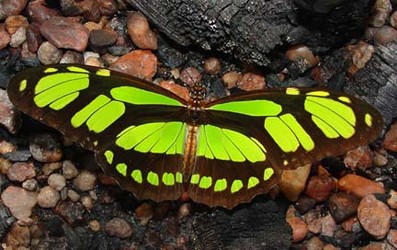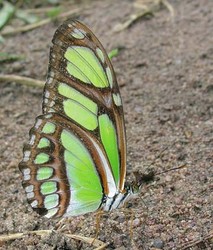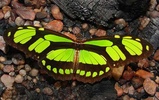Philaethria
Metamandana currently viewed as a subjective junior synonym
Andrew V. Z. Brower and Margarita Beltrán- Philaethria dido
- Philaethria diatonica
- Philaethria constantinoi (incertae sedis)
- Philaethria andrei
- Philaethria ostara
- Philaethria pygmalion
- Philaethria wernickei
Introduction
Species in this genus are recognized by the green pattern on the upperside and the typical heliconiine elongate forewing. The genus ranges from Mexico throughout Central and South America (DeVries, 1997).
The genus feeds on several subgroups of the genus Passiflora, and the larvae use the older leaves in all instars. The larvae appear very much like Heliconius, but the pupae lack spines and resemble a bird dropping. The adults are almost entirely restricted to the forest canopy, and do not feed on pollen. On the other hand, adults are occasionally seen visiting fresh mammal dung, a trait not seen in other heliconiines (DeVries, 1997). Flight is very rapid, and the butterflies are notoriously difficult to catch. Some have suggested that Philaethria species are mimicked by Siproeta steneles (Nymphalini).
References
DeVries P. J. 1997 The Butterflies of Costa Rica and Their Natural History, Volume I: Papilionidae, Pieridae, Nymphalidae Princeton University Press, Baskerville, USA.
Lamas G ed. 2004. Atlas of Neotropical Lepidoptera. Checklist: Part 4A Hesperioidea - Papiionoidea. Gainesville: Scientific Publishers/Association of Tropical Lepidoptera.
Salazar Escobar JA. 1991. Descripci?n de una nueva especie de Philaethria Billberg, 1820 para el occidente de Colombia (Lepidoptera: Nymphalidae: Heliconiinae). SHILAP Revta. Lepid. 19: 273-279.
Title Illustrations

| Scientific Name | Philaethria dido |
|---|---|
| Location | Alta Floresta, Mato Grosso, Brazil |
| Specimen Condition | Live Specimen |
| Identified By | Gill Carter |
| Life Cycle Stage | adult |
| View | dorsal |
| Source | Green Longwing |
| Source Collection | Neotropical Butterflies |
| Copyright | © 2003 Gill Carter |
| Scientific Name | Philaethria dido |
|---|---|
| Location | Brazil: Rond?nia, Porto Velho, Rancho Grande |
| Specimen Condition | Live Specimen |
| Identified By | Kim Garwood |
| Life Cycle Stage | adult |
| View | ventral |
| Source | Green Longwing (Philaethria dido) |
| Source Collection | Neotropical Butterflies |
| Copyright | © 2006 Kim Garwood |
About This Page

Middle Tennessee State University, Murfreesboro, Tennessee, USA

University of Cambridge, Cambridge, UK
Correspondence regarding this page should be directed to Andrew V. Z. Brower at and Margarita Beltr?n at
Page copyright © 2010 and
 Page: Tree of Life
Philaethria . Metamandana currently viewed as a subjective junior synonym.
Authored by
Andrew V. Z. Brower and Margarita Beltr?n.
The TEXT of this page is licensed under the
Creative Commons Attribution License - Version 3.0. Note that images and other media
featured on this page are each governed by their own license, and they may or may not be available
for reuse. Click on an image or a media link to access the media data window, which provides the
relevant licensing information. For the general terms and conditions of ToL material reuse and
redistribution, please see the Tree of Life Copyright
Policies.
Page: Tree of Life
Philaethria . Metamandana currently viewed as a subjective junior synonym.
Authored by
Andrew V. Z. Brower and Margarita Beltr?n.
The TEXT of this page is licensed under the
Creative Commons Attribution License - Version 3.0. Note that images and other media
featured on this page are each governed by their own license, and they may or may not be available
for reuse. Click on an image or a media link to access the media data window, which provides the
relevant licensing information. For the general terms and conditions of ToL material reuse and
redistribution, please see the Tree of Life Copyright
Policies.
- First online 25 March 2007
- Content changed 21 July 2010
Citing this page:
Brower, Andrew V. Z. and Margarita Beltrán. 2010. Philaethria . Metamandana currently viewed as a subjective junior synonym. Version 21 July 2010 (under construction). http://tolweb.org/Philaethria/70437/2010.07.21 in The Tree of Life Web Project, http://tolweb.org/










 Go to quick links
Go to quick search
Go to navigation for this section of the ToL site
Go to detailed links for the ToL site
Go to quick links
Go to quick search
Go to navigation for this section of the ToL site
Go to detailed links for the ToL site